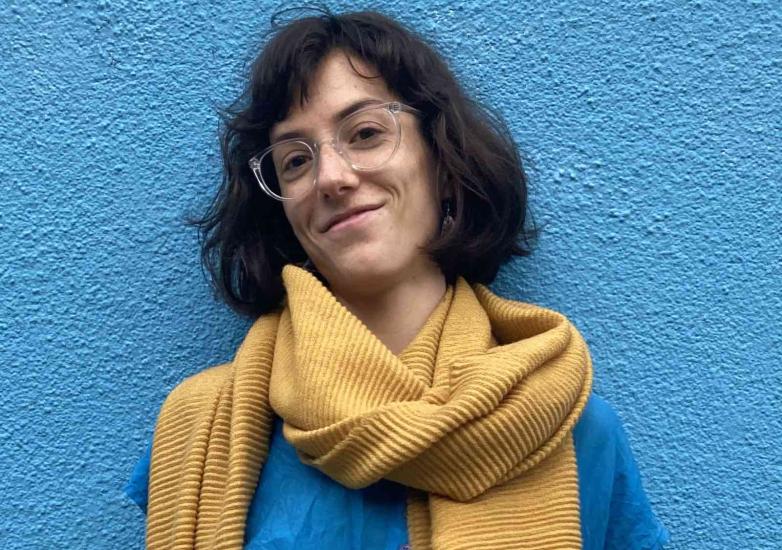Sorrel Dunn on Folk Art, Collecting Children’s Books, and Diversity in the Rare Book Trade

Sorrel Dunn
Our Bright Young Booksellers series continues today with Sorrel Dunn of James Arsenault & Company in Maine.
How did you get started in rare books?
I always knew peripherally about the book trade because my aunt is also a part of it, but it was never a career I had really considered (as a Philosophy major, perhaps I hadn’t really considered any career!) After graduating college and spending a few seasons building hiking trails in Vermont, my aunt recommended I meet Jim, and it just clicked. The first book I cataloged - during the interview in fact - was François Poulain de la Barre’s 1673 De l'égalité des deux sexes, and excepting a several-years’ hiatus to get my PhD, I’ve been cataloging ever since, although in reality I work more with other kinds of printed and manuscript material.
What is your role at James Arsenault & Company?
Like many in the book world, my roles are varied: the core of my job is certainly cataloging, but I also put together our PDF catalogs, do a lot of our packing and shipping, and recently revamped our database to enable us to take advantage of some new functionalities and streamline our workflows. The wonders and possibilities of database construction are endless, so this is an ongoing project as time allows. I also accompany Jim and his wife Lisa to several book fairs.
What do you love about the book trade?
The book world is filled with so many brilliant, curious, and kind people: it's a privilege and a pleasure to be part of a professional culture in which intellectual rigor goes hand in hand with enjoyment, enthusiasm, collaboration, and encouragement.
Describe a typical day for you:
Depending on where we are in the process of developing a catalog, the typical day will vary, but in general my work is fairly modular, and I appreciate having the flexibility to arrange segments of packing and shipping, research, writing, scanning and photo-editing, and so on to suit my inclinations and capacities over the course of the day. I’m interested in our systems and workflows, and my side-projects usually focus on facilitating them.
Favorite rare book (or ephemera) that you’ve handled?
Items that incorporate a dimension of folk art often attract me. A recent favorite in this vein is a bilingual Pennsylvania-Dutch handwriting sampler book from the 1830s, produced by Carl Friederich Egelmann, an important almanac calculator: in addition to examples of numerous German and English scripts and an original bilingual poem, it includes several copperplate engravings. Some of these show things like how to sit properly at your writing desk and how to hold your pen and paper effectively, but another, which is my favorite, portrays two lions with the most wonderfully morose grins you’ve ever seen.
Another highlight that I had the chance to spend time with was a substantial archive of writings and illustrated charts by a Michigan couple in the mid-20th century, which constituted quite an impressive mash-up of American (and cosmic) thought and culture. Their personal theory of evolution, beginning with “The Omeba,” was unfolded across a series of large, colorful, hand-drawn tableaux showing increasingly complex and idiosyncratically-labeled life forms, which were utterly captivating.
What do you personally collect?
I have two small and rather haphazard book collections running. The first sprang from my dissertation, which was about color theory and environment in German science and letters of the long 19th century. My academic scope was, by necessity, rather focused, but I was constantly running across other strands of color-thought that were equally fascinating, and often more bizarre and delightful. My collection currently has no discernible rules, but some of my favorite items so far include Ellie Irons’s recent volume of dye swatches made from plants around a Hudson Valley city, a book from the ‘80s containing a translation of the Lord’s Prayer into color, and a (modern) edition of Werner’s Nomenclature of Colors.
I also collect picture and children’s books. I’m often intrigued by illustrated works from authors who are better known for their adult publications, and especially enjoy books that cross-pollinate with the color collection, as in the case of another favorite, Ul de Rico’s The Rainbow Goblins.
What do you like to do outside of work?
I take a lot of joy in dabbling and puttering, and usually have multiple projects loafing around at the same time - knitting, sewing, making collages, trying not to kill my plants, and so on. Living in a body is nice, too, and I try to reciprocate the favor by running, doing yoga, lifting, and of course tromping through the woods and mountains and marveling at nature. It probably goes without saying that I love to read, although my literary appetite is still bouncing back after finishing my degree.
Thoughts on the present state and/or future of the rare book trade?
I’m very enthusiastic about the increasing elevation and support of young and more diverse collectors, librarians, and dealers. If capitalism both feeds and gobbles up the new, then it also thrives on forgetting the “old.” I don’t think my perspective here is original, but I believe that, collectively, preserving and engaging with as many cultural memories as possible is an important basis from which to strive for human and environmental flourishing. The more networks there are to support this collective memory, and the richer they are, the better. I’m excited for current efforts to enrich the overall perspective, expertise, and vision of the book world to continue to grow and bear fruit.
Any upcoming fairs or catalogues?
We will be exhibiting at the Ephemera Society show in Greenwich, Connecticut in March, and at the New York Book Fair in April: please stop by and say hello! Otherwise, keep your eyes peeled for our regular e-catalogs of Americana, maps, and, in the coming months, one of my favorite offerings, our “women in manuscript” list.















